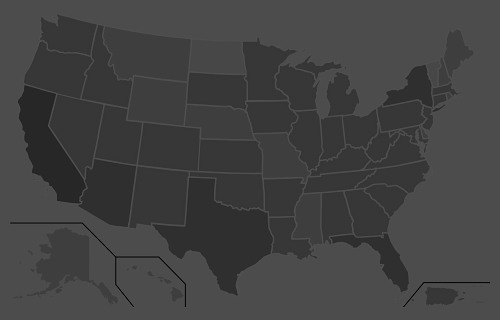“Our added winter moisture and active calling period led to a very long nesting and hatching season, starting in late April and extending into early summer, with chicks hatching as late as early July,” O’Dell said. “From a population standpoint, we are out of a deficit for the first time since 2001-2002. Quail are starting to pop up in places they haven’t been seen in a while.
“If you’ve never had the chance to experience what Arizona quail hunting built its name on, then this would be the year to get out and enjoy it.”
Meanwhile, hunters should note that the season for Mearns’ quail doesn’t begin until Dec. 4. It’s summer rainfall that plays a key role in nesting success and population numbers of this species. After a spotty and relatively weak monsoon across southern Arizona, these birds are likely to be abundant only in pockets that received sufficient precipitation this summer.
A valid Arizona hunting or combination hunt and fish license is required for all hunters 10 and older. Those hunters under 10 must either have a valid hunting or combination hunt and fish license, or be accompanied by an adult who possesses a valid hunting or combination hunt and fish license. Licenses can be purchased online or at license dealers statewide. A youth combination hunt and fish license (ages 10 to 17) is $5.
The general bag limit is 15 quail per day in the aggregate, of which no more than eight may be Mearns’ quail (when the Mearns’ season opens Dec. 4). The general possession limit is 45 quail in the aggregate after opening day, of which no more than 15 Gambel’s, scaled or California quail in the aggregate may be taken in any one day. After the opening of the Mearns’ season, the 45-quail possession limit may include 24 Mearns’ quail, of which no more than eight may be taken in any one day.
More quail-hunting information can be found on the department’s website at https://www.azgfd.com/Hunting/. Another resource for both new and experienced hunters alike is “An Introduction to Hunting Arizona’s Small Game.” Written by Randall D. Babb, the 196-page, full-color book covers where and how to hunt small game birds (like quail), squirrels, rabbits, ducks and geese. It also includes how to prepare and cook your harvest, with illustrations and recipes. The book can be ordered for $16.95 at www.azgfd.gov/publications.
Finally, hunters should check out O’Dell’s techniques for field-dressing quail at https://www.youtube.com/watch?v=3gRwZAcWzzk.
####
Publishers Notes: OUT OF STATE HUNTERS, FISHERMEN & OUTDOOR ENTHUSIASTS; Due to the Covid 19 pandemic, there could be limitations for OUT of STATE hunters, fishermen and other outdoor enthusiasts to include a 14-day quarantine requirement or negative COVID-19 testing alternative. Please check with the State's Department of Natural Resources BEFORE you travel or apply for the 2020 Fall Hunts.
Disclaimer: The views expressed on this site are that of the authors and not necessarily that of TBC Press
USFWS Returns Gray Wolves to Endangered Species List with Exceptions
Submitted by: TBC Press
Posted on: 02/21/22
The Backcountry Press
The country's premier daily HUNTING, FISHING & OUTDOOR news in the USA and around the globe. Read whats happening in your neck of the woods & beyond.
© 2020 TBC Press - All Rights Reserved Website Design by:
News # 14706
Under GFP’s management authority, trappers, sportsmen and women, landowners and livestock producers had the ability to harvest gray wolves across the state. Now, because wolves are no longer under GFP management, individuals may only harvest a gray wolf if it is posing a danger to human life.
U.S. District Judge Jeffrey White in Oakland, California, said the U.S. Fish and Wildlife Service had failed to show wolf populations could be sustained in the Midwest and portions of the West without protection under the Endangered Species Act. The service also didn't adequately consider threats to wolves outside those core areas, White said.
COLORADO
Since Colorado is not included in the Northern Rocky Mountains region, Colorado Parks and Wildlife no longer has direct control over the state's small but growing wolf population.
The decision has complicated legal implications in Colorado. In 2020, the state became the first where voters, not wildlife managers, mandated the reintroduction of the apex predators. The lack of federal protections meant the state didn't need permission from the U.S. Fish and Wildlife Service to carry out a requirement to release the species on the Western Slope by the end of 2023.
Under the new ruling, Colorado will lose its jurisdiction over wolves already living in the state. That comes as new arrivals have not just bred but also killed several cows and a dog in Jackson County.
For more information on the impact of court decision on Colorado see; colorado-gray-wolves-endangered-species-list/
SOUTH DAKOTA
The South Dakota Game, Fish and Parks (GFP) no longer has management authority over gray wolves, and they can no longer be hunted or trapped in South Dakota.
Over the past few years, South Dakota has had a handful of gray wolves killed on both sides of the Missouri River; however, South Dakota does not have a resident gray wolf population, said GFP Wildlife Director, Tom Kirschenmann. The gray wolves that have been present in South Dakota are transient animals that have dispersed from populations east and west of the state.
For more information, please visit gfp.sd.gov/wolf.
OTHER REGIONS
Wolves are now protected under the Endangered Species Act (ESA) as threatened in Minnesota and endangered in the remaining states. Critical habitat for gray wolves in Minnesota and Michigan and the 4(d) rule for gray wolves in Minnesota are also reinstated.
In Michigan it also means that two state laws governing the ability to kill wolves preying on livestock, pets and hunting dogs have been immediately suspended, according to the Michigan DNR. The now-suspended state laws are Public Act 318 of 2008, which allows hunting dog owners to remove, capture or use lethal means to destroy a wolf in the act of preying on the owner’s dog, and Public Act 290 of 2008, which offers the same provisions to livestock owners. Wolves in Michigan are now classified as a protected game species. It remains illegal to kill a wolf, except in defense of human life. Livestock owners will continue to be compensated for wolf depredation losses. Hunting of wolves while they are on the endangered species list is not permitted. Read more at; federal-gray-wolf-protections-restored-two-michigan-laws-suspended
For more information on wolves see; 2022 Gray Wolf Questions and Answers (pdf)
####
On February 10, 2022, a District Court decision ruled that the United States Fish and Wildlife Service (USFWS) must re-instate wolves under the Endangered Species Act (ESA) protections, with the exception of wolves in the Northern Rocky Mountains. Wolves still remain under state jurisdiction in Wyoming, Montana, Idaho and parts of adjacent western states after Congress exempted the area from federal protection in 2011.
After the Trump administration delisted wolves across all lower-48 states, a coalition of environmental groups sued the U.S. Fish and Wildlife Service to restore the protections. Their lawyers asserted the species continued to face significant threats across their historical range, especially as northern Rockies states approved aggressive wolf hunting.
The Biden administration defended the delisting effort in court. On Thursday, U.S. District Judge Jeffery White found the federal government had failed to prove wolf populations in the Midwest and parts of the West could sustain themselves without endangered species protections.












